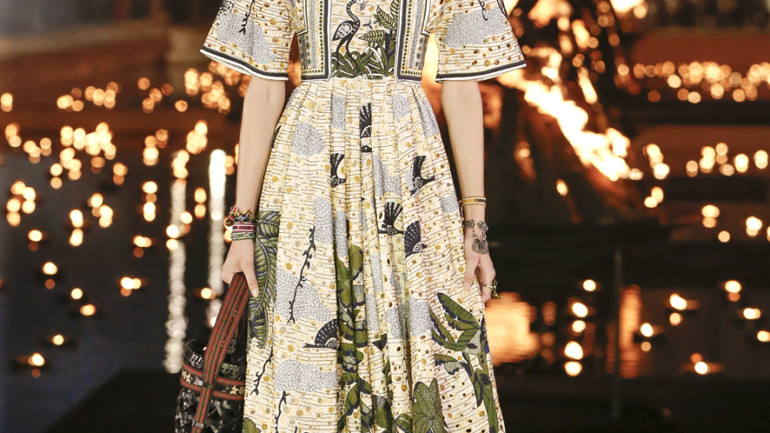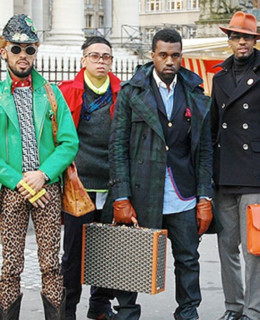“African prints” seem to be on everybody’s mind right now, but it seems there’s more behind this trend than just the revival of exotic imagery. First of all, let’s start by calling it “wax” and uncovering how multi-layered this fabric really is.
Take Dior’s 2020 Cruise Collection, for example: it was all about crossroads as Maria Grazia Chiuri inspired her rich clientèle to don African wax on their upcoming travels around the world. Conceived “like a map whose topography is lined with traditions, cultures and savoir-faire”, the collection was made up of different interesting collaborations, one notably involving Abidjan-based manufacturer Uniwax. The latter is one of the last strongholds of African wax fabric on the continent, using the original methods to create the elaborate double-printed textile. Grazia gave Uniwax’ artists total freedom in reinterpreting Dior’s iconic toile de Jouy, resulting in massive jungle creatures, mythical beasts, glowering icons and cheeky tarot references. The collaboration was championing the deep-rooted African fabric as a product of pure luxury, despite the massive threat of cheap imitations invading the territory. Dior isn’t the only fashion house trying its hand at wax, with both Western designers and public succumbing to its charm in recent years. Dries Van Noten, Jean Paul Gaultier, Junya Watanabe and Stella McCartney preceded the French luxury house, and a growing number of specialized wax brands are getting a foothold on the western fashion scene. Such as Odile Jacobs, the eponymous brand of a Belgian-Congolese midwife-turned-designer that causes sensation by bringing oversized dresses and shirts in Ghanaian prints to the Belgian public. “I combine Western design with African prints, which is my way of reuniting the traditions of two continents, just by introducing a new fabric to the people here.”

The tale of the mass-producing Dutchman and his redundant wax stock
Or should we say “re-introducing”? After all, and ironically enough, wax is originally not an African product at all. In fact, few fabrics are laced with as many different cultures and history as this one. As the pamphlet at Dior Cruise put it, “wax is a textile historically born in Asia, made in Europe and sold in Africa.” Its recent story starts in the second half of the 19th century, when colonials picked up the beautiful Indonesian batik tradition in the Dutch East Indies and decided to produce it on a mass scale. Batik, or ankara, is made by drawing patterns on cloth with hot liquid wax, which is hand-applied with a special etching tool. From there, the fabric is soaked in dye, which is prevented from covering the entirety by the wax. This process is repeated as often as additional colors are required, needless to say: it’s extremely time-consuming and hence expensive. The technique is thousands years old, nowadays recognized by the UN as a preserved cultural heritage, but back in the days, the practical Dutch manufacturers only noticed the inconvenience of such a slow process and decided to introduce it to the joys of industrialization. Many cotton printing mills flourished in those days across Europe, but one of them, P.F. van Vlissingen & Co, nowadays known as Vlisco, would soon emerge as the ultimate wax powerhouse –a position it still holds today.
Unfortunately, the fabrics weren’t received well on the Indonesian market, locals preferring the real traditional deal to what they considered cheap Dutch imitations. So instead, traders tried to sell their gigantic stock in Ghana -which was a regular stop on their trading route to the Indies. It became an immediate hit and the popularity of the fabric spread throughout West Africa and many sub-Saharan countries.


Do you speak wax?
Now how comes it was so well received in Africa, while further East people would turn up their nose? Besides the practical advantages of the sturdy, luxurious cotton, the enormous potential for storytelling struck a chord! Textile has always been an important aspect of African social life, even in pre-colonial times, having been used as currency and symbol of prestige for ages. People would bestow them at important events, such as births, marriages and other rites, evoking stories and traditions, which were traditionally collected by women over the course of their lives. There’s a very interesting essay written on this topic by the way, by Afro-American cultural anthropologist Paulette Young: “Ghanaian Women and Dutch Wax Prints” depicts how back then and still now, wax is perceived as a valuable possession and people give their own meaning and background to its prints.
So yes, the industrially produced cloth may not have been as noble as the revered Indonesian batik, but that didn’t matter to the African public, who considered the colorful fabric the perfect blank canvas to tell their own stories –and thàt is what makes wax inherently “African”. It may descend from Eastern tradition, it may have been designed and produced in Europe, but it speaks the language of Africa. To this day, a company such as Vlisco has created more than 350,000 original textile designs, many of which have become cultural treasures bestowed with special names and meanings, both traditional and surprisingly modern, by their African customers. For instance, what the Dutch employees of the company refer to as the “VL00549.096“ print, is called “Anansi’s Spider Web” by its Ghanaian wearers, after a West-African, spider-shaped spirit believed to be the source of all knowledge and stories. Another print, neutrally named the “VL03263.007”, is referred to as “Television” by Nigerian women, because of the boxed structures that seems to depict motion pictured stories. As such, today’s African wax print designs include pop culture and art references, but also every day items like TVs. There are also commemorative designs, remembering important historical events. Such as Vlisco’s Nelson Mandela hommage, launched in 1990 upon the ANC leader’s release after 27 years of imprisonment. The print in itself is of great historical value, as before 1990 South-African law forbade to portrait Mandela or use the ANC colors in public.


Waving wax
Today, a new page is added to the colorful history book of wax as the West is (re)discovering the fabric, along with the growing potential of Africa’s fashion industry. Not only are Western designers inspired by the colors and forms of the old continent, but there is finally some genuine interest for African-born designers and their work as well. Events such as Lagos Fashion Week and Nigerian Design Week are ranking high on the radar of Western editors and stylists, while celebrities like Michelle Obama, Lupita Nyong’O and Beyoncé Knowles wear and promote the designs of promising talents such as Maki Oh, Lisa Folawiyo, Loza Maleombho and Prime Obsession. The winner of LVMH’s 2019 Prize is Johannesburg-based Thebe Magugu, which speaks volumes too. The highly expressive and recognizable wax is not only a symbol of black pride, worn all over the world by people of African descent to show their cultural heritage. It also tells the tale of the economic and cultural force of an entire continent. There’s one big catch to this story however, and that is the danger of overlooking Africa’s enormous plurality and cultural diversity. The continent is rich with fifty-four countries, each with their own crafts and fashion traditions, but also with modern young designers and creatives who bring new ideas to the table. It would hardly be fair to measure this rich heritage over the same, waxed yardstick. That is why retailers like The Folklore, a platform specialized in African fashion, intentionally exclude wax from their offer, choosing to offer visibility and selling opportunities to other aspects of African design. Which is fine as well.

Other voices raise concerns about cultural appropriation, stating Western customers have no business wearing symbolical African prints. Stella McCartney, for one, has been heavily criticized for using wax in a fashion show that was dominated by white models. “Nonsense,” say as many others, like Odile Jacobs: “we are proud to share our culture and it’s uplifting that the West is genuinely interested in our vision on fashion.” As long as people understand and respect what they are wearing, all is well in the land of multicultural prints, right? Almost right: the biggest challenge for Africa’s growing fashion industry, is to keep it inherently African. Many local designers still don’t have the right access to fabrics, retailers and manufacturers, by lack of financial means. They have to turn to foreign investors, or see their ideas being copied and carried out in cheap Asian plants, skipping the opportunity to genuinely develop the local economy. Employment and independence are key here, but with most of the factories on African soil still controlled by foreign powers, or not being able to compete with international competitors, there is still a long way to go. Last but not least, the question of sustainability deserves to be raised: as a relatively young industry, Africa’s relatively fashion scene still has the opportunity to distinct itself from its predecessors by implementing environmental-friendly procedures right from the start, although this will no doubt prove to be an economical challenge as well. Maybe that is the new story to be told, as cheerful wax prints become the instigator of a fierce dialogue, forming the perfect flag of Africa’s cultural and economical revolution.




